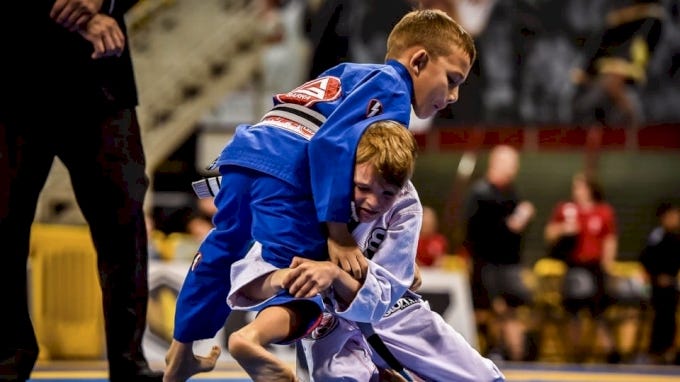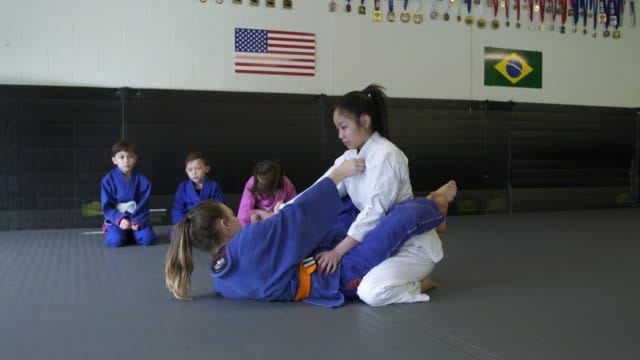An Analysis of a Jiu Jitsu Curriculum
Eric's insanity continues with an analysis of a kid's jiu jitsu program curriculum.
In the last Grapple Hut article, I spent a good deal of time discussing curriculum concepts and how they can relate to jiu jitsu. It just also happened to coincide with some work I was doing on that topic. This is an edited down analysis I did on a kid’s jiu jitsu program at my last jiu jitsu gym.
You may be asking, “why is this important and why is this worth reading?” The relevance of this paper is that designing a curriculum program is rather tricky and, this is the big part, even more tricky to ensure your students take away the intended learning you’re presenting them. This is a regular issue and problem that plagues most sports, and in jiu jitsu its a common thread of discussion.
So this is an honest and open look at a program I designed and enacted as the teacher and should serve as some food for thought.
Analysis of a Children’s Jiu Jitsu Program Curriculum Implementation
This is an analysis of the implementation of a kid’s jiu jitsu program’s curriculum at my jiu jitsu gym. The program was part of an expansion of classes available for children at my local gym, which we’ll call BJJ School. The curriculum was designed and implemented solely by myself. It was created to be a 16 week long program, with classes taking place two hours per week. The kid’s participating in the program ranged from the age of five years-old to ten years-old and had no prior experience.
When looking at curriculum in the context of a jiu jitsu gym, the intended curriculum takes the form of the specific technique, or system of techniques, to be taught in a set order or chain so as to achieve desired results in a simulated sparring session or competition setting. The intention, in this case, was to achieve the following over the course of the program:
· Learning key English words and phrases (the students were ESL learners).
· Learn specific sequences of jiu jitsu techniques and chains.
· Develop related body mechanics and control.
· Encourage social development with regards to teamwork and discipline.
In the situation I was put in, no curriculum existed at the time of the establishment of the children’s jiu jitsu program, nor was there a curriculum designed for the adult’s program to base a children’s program off of. Therefore a new curriculum, designed by myself, was necessary. The aims for the program were shaped by what the head coach at BJJ School viewed as the base standards. Due to the autonomy given to me, I was also allowed to add in elements from external curriculum such as the Gracie University Bully Proof activities and games, as well as personal guidance via communique with other children’s coaches through a social network of jiu jitsu hobbyists.
Since I was the sole educator, it was my responsibility to track and maintain how effectively the intended curriculum was enacted during the lessons. Unbeknownst to me at the time, my preparation work for each of the training sessions followed the curriculum strategy framework as described by educational researchers Sherin & Drake. To summarize their findings, there are three phases of curriculum strategy; reading, evaluating, and adapting. Reading comes when the instructor reviews the written documents and goals as an overview prior to and during instruction. The evaluating stage comes when a teacher focuses on needs of the learners and deciding if the curriculum is appropriate. The third stage, adapting, happens when the instructor creates, replaces, or omits components from the curriculum during the instruction.
So, prior to each lesson I would review the written curriculum to ensure I knew what the goals for the day. Then, I would determine which of the techniques being focused on would be most suitable using what I understood of the abilities of the students displayed in previous lessons. Finally, I would then adapt the curriculum for that day by typically adding additional steps to the learning process to ensure a more clear line of knowledge was established.
Looking at the experienced curriculum of the students, in jiu jtsu it is typically seen in the form of the child developing a sense of deep understanding on the timing of using specific techniques such as leverage, pressure with their body, and allowing them to complete a desired technique efficiently. In addition to this, experienced curriculum can also apply to the mental and psychological development of the child, such as developing the ability to maintain a calm and focused demeanor during a competition after the experiences of sparring and competing over time. It was observed that the students’ ability to enact specific moves, typically ones the child preferred or found to be easier due to the shape of their body.
When looking at the curriculum, it is important to assess the alignment of goals as stated as part of the intended curriculum. Keeping in mind that there are opportunities for both alignment and misalignment to occur between the Intended-Enacted Curriculum it’s worth pointing out where such issue occurred for further improvements. One area of alignment was that the instruction of the techniques did follow the intended curriculum and its overall plan. For example, “shrimping” was taught as a basic movement and after the first lesson exposed them to it the children were able to competently perform it.
When it came to misalignment however, it noted that pacing and introduction of certain body mechanic techniques were too fast for the children to develop. Mostly in the sense that they were being given information overload. To combat this it became necessary to omit or adapt the curriculum so as to add in additional steps to teaching certain body mechanics.
Another challenge with alignment was the issue of a language barrier existing between myself and the learners. As a native English speaker, one of the intended focuses of the program was to do all instruction in English to allow for exposure to the language for the non-English speaking learners. This goal was mostly met, but there were numerous instances of the students clearly struggling to understand me. In turn this would cause confusion and an inability to perform the technique being shown to them. An example of this is rather than saying “use C grips”, I had to adjust the word choice I was giving the kids to be “Lego hands” as it was a concept they were more familiar with.
The issues with communication weren’t just seen in the intended-enacted curriculum relationship, and can also be seen in the enacted-experienced relationship. At times they struggled to understand and execute the shown techniques effectively. There was a clear lack of comprehension on the specific body mechanics they were asked to perform which would cause a child to struggle and then grow frustrated with.
Despite the misalignment, there were also examples of proper alignment in the enacted-experienced curriculum relationship. This mostly came in the form of the students, during both sparring sessions and in competition, being able to perform several of the techniques they have been taught and had instruction on. There was also alignment between stated goals of the program when the students consistently showed good sportsmanship and behavior while at a competition.
A question you may now ask is, “What can be done to address misalignment?” One solution can be to perform a total reassessment of the curriculum from the start. Because the guidelines that were given were so vague, it implies that further detail may be necessary. Allowing for a more experienced instructor to guide me in the creation of the curriculum could have prevented any issues with introducing overly complicated techniques too early.
Similarly, the choice of focusing on giving instruction only in English to students who do not speak the language may need to be reversed. Teaching someone in their own native language leads to less confusion and breakdown in communication. As I mentioned, there were several issues with the students not understanding the instruction due to not having a strong understanding of English.
There is also an argument to be made that emphasis should be not on the jiu jitsu techniques per se, but focusing on body movement and body mechanic exercises instead. This is mostly based around research that shows children at certain ages benefit better from focusing exercise on specific body mechanics that a jiu jitsu class would not necessarily focus on. For more information on this I’d recommend you look at Sport For Life’s guidelines. This is an argument I think is valid as there were issues with kids struggling to perform certain body mechanics because they lacked the control or coordination skills needed. So they had to focus on developing those first, which interrupted the learning process of the jiu jitsu technique.
Finally, splitting the classes up from a singular class covering such a wide age range to allowing for multiple classes with each one having a specific age restriction would help. The rationale for this is that it would allow for sparring to occur between participants who are of equal size and strength, and for social development to occur on a more equal level between the students.
To summarize all of this, the process of implementing this program required a lot of work and consideration that, at the time, I was not fully aware of. There are so many theories and concepts at play when it comes to designing and introducing curriculum to a student that not everyone is aware of. While you may think that you want to eliminate any misalignment, that is utterly impossible. No matter what they will happen and there’s genuinely nothing you can do to stop that. However, when it comes to curriculum implementation it’s better to identify where the misalignment happens, why they happen, and what can be done to adjust your curriculum to lessen the negative effects.





